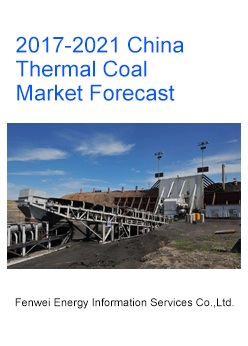
Date of completion: April , 2017
TOTAL: US$ 7000
Online Self-purchase
Among China total energy consumption, coal accounts for more than 60%; while thermal coal holds about 85% of total coal burn. China coal industry stepped onto a downturn since 2012, making coalminers struggle against serious overcapacity and price drop. In the context of economic restructuring, Chinese government launched the supply-side reform since 2016 by means of decapacity and 276-workday reducing production.
During the 13th Five-Year-Plan period, China will keep phasing out backward coal capacity, and the national economy is expected to show an“L”-shape growth, making the thermal coal market outlook especially worth of attention.
This report will review China thermal coal market during 2012-2016, from the aspect of supply, demand, import & export, prices and logistics, and then look into 2017-2021 by integrating with GDP growth, industry policies, thermal coal capacity and demand from downstream sectors.Part 1: 2012-2016 China Thermal Coal Market Review
1 Introduction of Thermal Coal
1.1 Definition and classification
1.2 Quality indicators
1.3 Main application
2 Relevant Policies for Coal Industry
2.1 Energy policies (adjustment of energy consumption mix, and energy industry development)
2.2 Coal industry policies
2.2.1 Policies for coal resource consolidation, industrial layout and safety production
2.2.2 Policies for taxes and administrative charges (resource tax reform and coal-related funds, etc.)
2.2.3 Management measures for commercial coal quality
2.2.4 Policies for coal import and export
2.2.5 Supply-side reform (coal industry decapacity)
2.3 Policies for environmental protection and air pollution prevention & control
3.1 Total consumption and trend
3.2 Consumption by industry
3.2.1 Power industry
3.2.2 Building materials industry
3.2.3 Chemical industry
3.2.4 Metallurgical industry
3.2.5 Other industries
4 Thermal Coal Supply
4.1 Total supply and trend
4.2 Supply by province
4.3 Supply by major suppliers
5 Thermal Coal Imports and Exports
5.1 Total imports
5.2 Major importing provinces and origins
5.3 Total exports
5.4 Major exporting provinces and destinations
5.5 Net imports
6 Supply-demand Pattern and Price Trend
6.1 Supply-demand pattern
6.2 Price trend
6.2.1 Prices at production regions, transfer ports and consumption regions
6.2.2 Price comparison between domestic and import same-CV cargoes
7 Logistics Pattern and Freight Variation
7.1 Logistics pattern
7.1.1 Main flow directions
7.1.2 Main transport routes and cargo volume by rail/road/water
7.1.3 Coal volume by rail/road/water
7.2 Freight variation
7.2.1 By rail
7.2.2 By road
7.2.3 By water
Part 2: 2017-2021 China Thermal Coal Market Forecast
8 Thermal Coal Demand
8.1 Energy consumption plan
8.1.1 Total consumption and trend
8.1.2 Unit consumption and trend
8.2 Demand from power industry
8.2.1 Thermal and non-fossil energy installed capacity
8.2.2 Unit coal burn and power generation of thermal generating units
8.2.3 Total thermal coal consumption
8.3 Demand from building materials industry
8.3.1 Clinker output, unit coal burn and total thermal coal consumption for cement
8.3.2 Proportion of coal for cement in total thermal coal use in building materials industry
8.4 Demand from chemical industry
8.4.1 Output of traditional chemicals (synthetic ammonia & methanol) and thermal coal burn
8.4.2 Output of new-type chemicals (CTL & CTNG) and thermal coal burn
8.5 Demand from metallurgical industry
8.5.1 PCI coal burn for blast-furnace iron-making (incl. anthracite, meager coal & high-vol bituminous coal)
8.5.2 Coal burn for iron ore sintering
8.6 Demand from other industries
9 Thermal Coal Supply
9.1 Capacity
9.1.1 Forecasting basis
— Coal industry policies
— Capacity breakdown
— Mine construction and commissioning
9.1.2 Capacity forecasting result
9.2 Supply
9.2.1 Thermal coal output
— Capacity utilization rate and influencing factors
— Output forecast
9.2.2 Coking coal middling output
9.2.3 Thermal coal total supply
10 Thermal Coal Imports and Exports
10.1 Imports
10.1.1 Influencing factors
10.1.2 Import volume
10.2 Exports
10.2.1 Influencing factors
10.2.2 Export volume
10.3 Net imports
11 Price forecast
11.1 Influencing factors (supply-demand pattern, policies, inflation, substitutive energy)
11.2 Benchmark coal price forecast (QHD5500, QHD5000)
12 Logistics Pattern and Cost Variation
12.1 Logistics pattern
12.1.1 Transport routes being constructed and planned
12.1.2 Coal volume by rail/road/water and via main transport routes
12.2 Transport cost variation
12.2.1 2012-2016 Freight by rail/road/water
12.2.2 2017-2021 Freight forecast by rail/road/water
Hot-sale Products